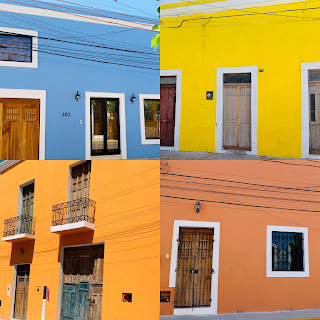Our summer 2019 vacation was met with anticipation. While in 2018 we were excited to spend a month in London, England, this time we decided it was time to spend time in our own native country and to top it off, we decided that one month was not enough so we added two extra weeks to make our stay a total of 6 weeks.
The idea was that if we were willing to spent a month in Europe, visiting castles and enjoying architecture, why not enjoy the same in our own country? And so, the trip began with two weeks in Merida, Yucatán, México. And while we anticipated it that it was going to be a hot summer, we were not really ready for a 100% humidity every single day we were in Yucatán. So, if in some pictures we look like we are wearing two colored shirts, that is because they are soaked in sweat.
Merida is a beautiful, colorful very colonial and very Indigenous city. The native people are all 100% Maya people and they speak the Maya language. In fact, most Mayas today are bilingual, speaking Maya and Spanish. Many are trilingual, speaking Maya, Spanish, and English. Some are polyglots, speaking up to five languages, including French, German, Dutch, and Portuguese.
Merida (as well as the entire state of Yucatán) is very proud of its Indigenous roots and traditions, for this reason, the city hosts free cultural events everyday of the week. Tourists, like ourselves, can enjoy different events depending on the day of the week. We arrive on a Wednesday and on that evening we saw a dramatic presentation about the founding of the city.
The dramatic presentation takes place on the street, in front of one of the oldest and most beautiful houses in the city's center, La Casa de Montejo. The dialogue is between a Maya Chief and the son of aSpanish conquistador named Francisco de Montejo, the lieutenant. Hi son, also named Francisco de Montejo (because Spaniards are very creative with family names) was known as "El Mozo" (the son) and he's the one that conquered the Maya city known as T'ho. In the dramatization, the Maya Chief and The Mozo have an exchange of dialogue that relates how T'ho has been destroyed and taking over by Montejo and then given the name of MERIDA, to honor the original Merida in Extremadura, Spain. For me, the best part of the dialogue was the following (and I'm paraphrasing):
Maya Chief: "You have destroyed our houses, our temples, T'ho, our city."
Maya Chief: "Our city, T'ho, is no more."
El Mozo: "Your city is the foundation of our ours."
One thing I loved about every single cultural presentation was the fact that regardless of what it was, there was always a consciousness to let the audience know that the Merida and the entire state had been colonized by the Spaniards, and that despite such colonization, the Maya still thrives.
One of my favorite presentation was the Vaqueria Yucateca, which is basically a presentation of Maya/Yucatán customs from all over the state. This presentation, however, is done through traditional folklore dancing.
An exciting presentation is watching Maya people play soccer, also known as Pelota Maya or in original name: Poktapok. The game is like today's game except that instead of using their feet to hit the ball, they have to use their hips. Not easy to do and not easy to score a goal either.
A very colorful presentation is what is called "mapping," which is basically projecting images on stone buildings. In this case, the mapping had to do with Merida's main church, La Catedral de San Idelfonso, (Saint Idelfonso Cathedral). The mapping tells you the story of two buildings: A pyramid, which I forget its name and the cathedral... and how the cathedral was built on top of the pyramid (as the colonizers did to EVERYTHING in Mexico and Latin America). The image below shows where the pyramid used to be, of course, now reflected onto the cathedral's main entrance wall. At the end, the storyteller says, "two gods, two cultures fused into one." And very subtle it reminds people of the colonization and how the Maya people continue to thrive with their own traditions.
Moral of the story: The Maya might have been conquered but they still alive, thriving, and spreading their traditions to the world.
NEXT: CHICHÉN-ITZÁ








No comments:
Post a Comment